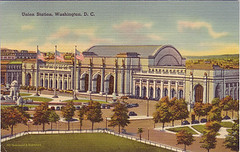I'm shocked, shocked...

Greater Greater Washington reports in more depth about the hearing initiated by Delegate Norton on Union Station, in "Norton berates Union Station reps over photography, intermodal plans." It's also covered in today's Post, in "Photographers Detail Difficulties Shooting Facility: Group Complains of Interference."
I find it funny that people, including Delegate Norton, are just noticing that Union Station, for the most part, has little oversight. That's the way that Congress set up the quasi-government entity to take it over.
Organizational structure is destiny. Fred Kent of Project for Public Spaces has a line something like this:
If you design places for cars and traffic, you get cars and traffic. If you design places for people and activity, you get people and activity.
Well, if you design organizations to have little oversight, and no responsibilities to the greater public, you get organizations with little oversight, insulated and disconnected from the public they are supposed to serve.
And you can tell that the Union Station Revitalization Corporation doesn't care all that much about historic preservation and architecture, or they wouldn't have built such an ugly parking structure on the back of an incredibly beautiful building.
At a hearing years ago, I referred to the first part of the garage as "prison architecture" and said that the proposal for the extension (now built) was an improvement only by comparison, looking more like "cheap public housing."
Union Station barely noticed that last year was the 100th anniversary of its opening. Although they do try to leverage the historic nature of the building in terms of its marketing.

"Shop where history lives."
For one, I'd have a set of historical-cultural information markers and a wayfinding system, especially to explain how to use transit. And a visitors information center--20+ million people go through Union Station each year. Etc.
But there's almost no way for these kinds of proposals to be made-pushed, under the current setup. And because they don't have to be too responsive to the public, they don't think about it on their own anyway.
Then there is the whole intermodal issue. Yes, inter-city buses should be run out of Union Station. They aren't. Because Union Station isn't really accountable, they didn't have to address it. Sure the people who ride traditional Greyhound buses are poorer, etc., but that doesn't mean that they shouldn't be served. (Of course, the bus station could have been incorporated into the New York Avenue station instead, but that's another missed opportunity.)
For information about the history of Union Station, check out Bill Wright's dissertation, which is incredibly well-written and broken up into easily readable chapters.
Labels: government oversight, provision of government services, public assets, transportation planning



0 Comments:
Post a Comment
<< Home